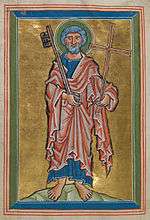The Venerable
The Venerable is used as a style or epithet in several Christian churches. It is also the common English-language translation of a number of Buddhist titles, and is used as a word of praise in some cases.
Christianity
Roman Catholic
| Part of a series on the |
| Hierarchy of the Catholic Church |
|---|
 |
| Ecclesiastical titles |
|
|
Liturgical titles |
|
Administrative and pastoral titles
|
|
Consecrated and professed titles |
|
|
In the Latin Church of the Catholic Church, after a deceased Catholic has been declared a Servant of God by a bishop and proposed for beatification by the Pope, such a servant of God may next be declared venerable ("heroic in virtue") during the investigation and process leading to possible canonization as a saint. Before a person is considered to be venerable, that person must be declared as such by a proclamation, approved by the Pope, of having lived a life that was "heroic in virtue", the virtues being the theological virtues of faith, hope, and charity and the cardinal virtues of prudence, justice, fortitude, and temperance. The next steps are beatification, from which point the person is referred to as The Blessed, and finally canonization, from which point he is referred to as Saint. For example, Popes Pius XII and John Paul II were both declared venerable by Pope Benedict XVI in December 2009 and John Paul II was declared saint in 2014.[1]
Other examples are Princess Louise of France, Francis Libermann, and Don Juan de Palafox y Mendoza, seventeenth-century bishop of Puebla, Mexico.
The 7th/8th century English monk St. Bede was referred to as venerable soon after his death and is still very often called "the Venerable Bede" despite having been canonized in 1899.
This is also the honorific used for hermits of the Carthusian Order, in place of the usual term of "Reverend".
Anglican
In the Anglican Communion, "The Venerable" (abbreviated as "the Ven") is the style usually given to an archdeacon.[2]
Eastern Orthodoxy
In the Orthodox Church the term "Venerable" is commonly used as the English-language translation of the title given to monastic saints (Greek: Hosios, Church Slavonic: Prepodobni; both Greek and Church Slavonic forms are masculinum).
A monastic saint who was martyred for the Orthodox faith is referred to as "Venerable Martyr".
In the 20th century, some English-language Orthodox sources began to use the term "Venerable" to refer to a righteous person who was a candidate for glorification (canonization), most famously in the case of Saint John of Shanghai and San Francisco; however, this has not altered the original usage of this term in reference to monastic saints.
Buddhism

In Buddhism, the Western style of Venerable (also abbreviated as Ven.) is given to ordained Buddhist monks and nuns and also to novices (Śrāmaṇeras). The title of Master may be followed for senior members of the Sangha. "Venerable", along with "Reverend" (Rev.) is used as a western alternative to Mahathera in the Theravada branch and Făshī (法師) in Chinese Mahayana branch.[3]
See also
References
- ↑ "Report: Pope Francis Says John Paul II to Be Canonized April 27". National Catholic Register. 3 September 2013. Retrieved 6 September 2013.
- ↑ "How to address the clergy", Crockford's Clerical Directory website.
- ↑ Titles of the Monks and Nuns of the Western Buddhist Monastic Gathering
| Look up Venerable in Wiktionary, the free dictionary. |